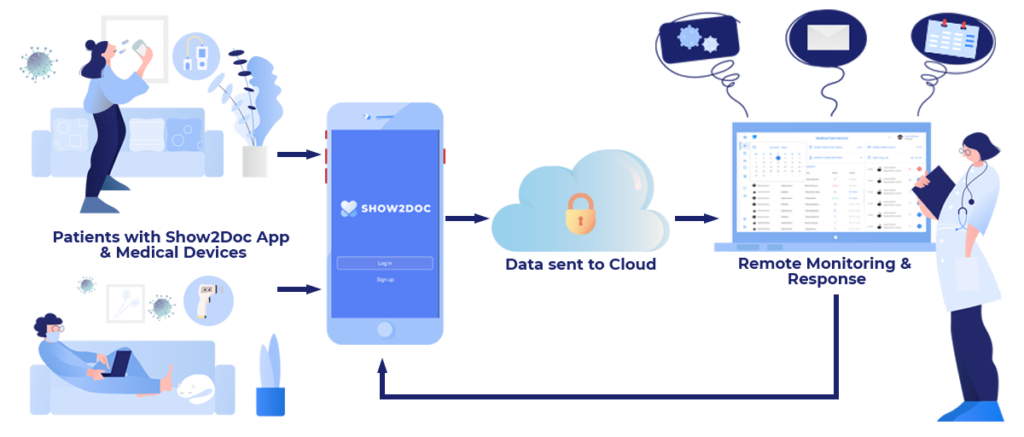Revolutionizing Healthcare: The Role of Mobile Technology in Remote Patient Monitoring

Introduction
The healthcare landscape is undergoing a transformative shift, with mobile technology playing a pivotal role in enhancing patient care and outcomes. Remote Patient Monitoring (RPM) is a dynamic healthcare approach that empowers individuals to manage their health conditions from the comfort of their homes, thanks to mobile devices and advanced healthcare applications. In this article, we will explore the profound impact of mobile technology on RPM, its benefits, challenges, and the importance of maintaining data integrity and avoiding plagiarism in the realm of remote patient monitoring.
- The Evolution of Remote Patient Monitoring
Remote Patient Monitoring (RPM) is not a new concept, but advancements in mobile technology have revolutionized its implementation. RPM allows healthcare providers to collect and analyze patient data in real-time without the need for frequent in-person visits. Here’s how mobile technology has transformed RPM:
Wearable Devices:
Mobile-connected wearable devices, such as smartwatches and fitness trackers, enable continuous monitoring of vital signs, activity levels, and even ECG data.
Mobile Apps:
Health and wellness apps provide patients with user-friendly interfaces for tracking and reporting their health data. These apps often integrate with wearable devices for seamless data transmission.
Telehealth Services:
Mobile technology enables video consultations and remote doctor-patient communication, enhancing the RPM experience.
Data Analytics:
Advanced data analytics tools process the vast amount of patient data generated by mobile devices, providing valuable insights to healthcare providers.
- The Pros of Mobile Technology in RPM
Real-Time Data:
Mobile-connected devices provide real-time health data, allowing immediate intervention in case of anomalies or deterioration in a patient’s condition.
Convenience:
Patients can manage their health without frequent clinic visits, reducing the burden of travel and waiting times.
Early Intervention:
RPM facilitates early detection of health issues, enabling timely medical intervention and potentially preventing complications.
Improved Patient Engagement:
Mobile apps and wearable devices engage patients in their healthcare journey, motivating them to take an active role in managing their health.
Cost Savings:
RPM can reduce healthcare costs by minimizing hospital readmissions and emergency room visits.
- Challenges in Mobile-Based RPM
While mobile technology has immense potential in RPM, it also presents challenges that must be addressed:
Data Security:
Protecting patient health data from cyber threats and breaches is paramount. Strong encryption and security measures are essential.
User Adoption:
Ensuring that patients, especially older adults, can use mobile devices and apps effectively is a challenge. User-friendly interfaces are crucial.
Data Overload:
The volume of data generated by RPM can be overwhelming for healthcare providers. Streamlining data analysis is necessary.
Regulatory Compliance:
Adherence to regulatory standards, such as HIPAA in the United States, is essential to ensure patient privacy and data security.
- Data Integrity and Avoiding Plagiarism in RPM
Maintaining data integrity is a critical aspect of RPM, as patient data is the cornerstone of healthcare decisions. Plagiarism or data tampering in RPM can have severe consequences, including misdiagnosis and mistreatment. Here’s how to uphold data integrity and prevent plagiarism in mobile-based RPM:
Accurate Data Collection:
Ensure that all patient data collected through mobile devices is accurate and complete. Any errors can lead to incorrect medical decisions.
Data Source Attribution:
When integrating data from external sources, such as wearable devices, always attribute the source to provide transparency and accountability.
Data Security:
Implement robust data security measures to protect patient records from unauthorized access, breaches, or data theft. Compliance with data protection regulations is critical.
Ethical Data Use:
Use patient data ethically and responsibly, adhering to all relevant privacy and ethical standards. Patient consent should be obtained for data sharing and research purposes.
Data Verification:
Regularly verify patient data for accuracy and consistency. Cross-referencing information can help identify discrepancies or errors.
- The Future of RPM and Mobile Technology
The future of RPM is promising, with mobile technology continuing to drive innovations in healthcare.
Here are some trends and developments to watch for:
AI and Machine Learning:
AI-driven algorithms will enhance data analysis, enabling predictive and prescriptive insights for better patient care.
IoT Integration:
The Internet of Things (IoT) will connect a wide range of medical devices, expanding the scope of RPM.
Remote Monitoring Beyond Chronic Conditions: RPM will extend beyond chronic disease management, encompassing post-operative care, pregnancy monitoring, and more.
Personalized Medicine:
Mobile technology will facilitate personalized treatment plans, tailoring healthcare to individual patients’ needs.
Global Expansion:
RPM will become more accessible worldwide, bridging healthcare gaps and increasing patient access to quality care.
Conclusion
Mobile technology has reshaped the landscape of healthcare, particularly in the realm of Remote Patient Monitoring (RPM). This innovative approach empowers patients to take charge of their health while enabling healthcare providers to deliver more personalized and timely care. However, with the vast amount of patient data being generated and transmitted via mobile devices, maintaining data integrity and avoiding plagiarism are paramount. The ethical use of patient data, robust data security measures, and adherence to regulatory standards are fundamental to the success of mobile-based RPM. As technology continues to advance, the future of RPM holds even greater potential, promising improved patient outcomes and a more patient-centric approach to healthcare. Mobile technology is a cornerstone of this transformation, paving the way for a healthier and more connected world.



